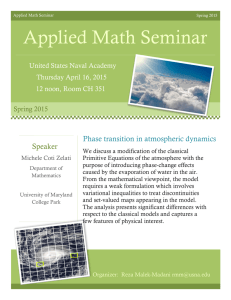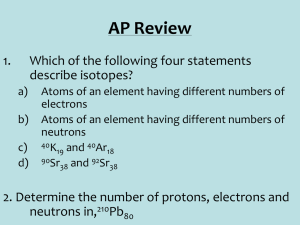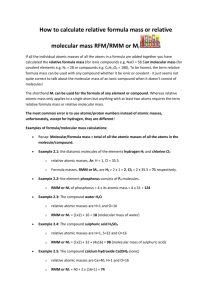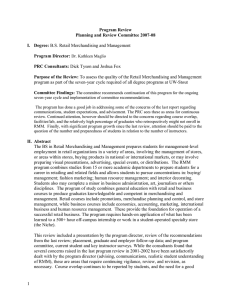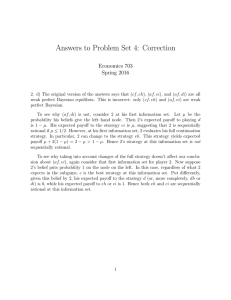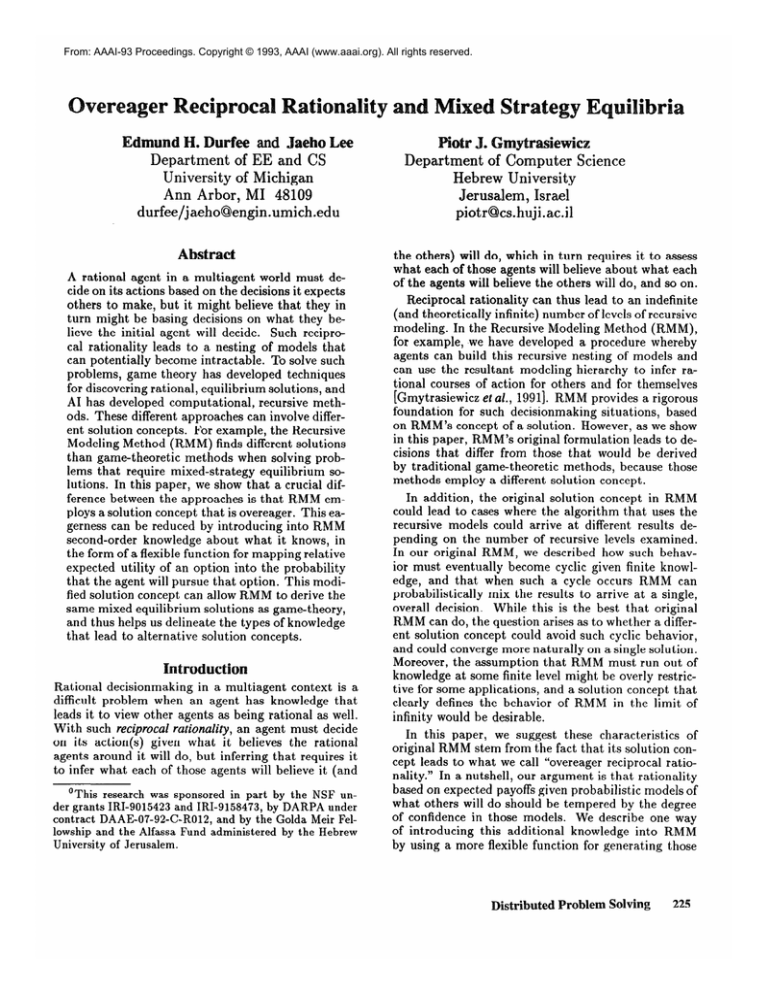
From: AAAI-93 Proceedings. Copyright © 1993, AAAI (www.aaai.org). All rights reserved.
University of Michigan
Ann Arbor, MI 48109
durfee/jaeho@engin.umich.edu
A rational agent in a multiagent world must decide on its actions based on the decisions it expects
others to make, but it might believe that they in
turn might be basing decisions on what they believe the initial agent will decide.
Such reciprocal rationality
leads to a nesting of models that
can potentially become intractable.
To solve such
problems, game theory has developed techniques
for discovering rational, equilibrium solutions, and
AI has developed computational,
recursive methods. These different approaches can involve different solution concepts. For example, the Recursive
Modeling Method (RMM) finds different solutions
than game-theoretic
methods when solving problems that require mixed-strategy
equilibrium solutions. In this paper, we show that a crucial difference between the approaches is that RMM employs a solution concept that is overeager. This eagerness can be reduced by introducing into RMM
second-order
knowledge about what it knows, in
the form of a flexible function for mapping relative
expected utility of an option into the probability
that the agent will pursue that option. This modified solution concept can allow RMM to derive the
same mixed equilibrium solutions as game-theory,
and thus helps us delineate the types of knowledge
that lead to alternative solution concepts.
Rational decisionmaking
in a multiagent
context is a
difficult problem when an agent has knowledge that
leads it to view other agents as being rational as well.
With such reciprocaZ rationality, an agent must decide
on its action(s)
given what it believes the rational
agents around it will do, but inferring that requires it
to infer what each of those agents will believe it (and
‘This research was sponsored in part by the NSF under grants IRI-9015423 and IRI-9158473, by DARPA under
contract DAAE-07-92-C-R012,
and by the Golda Meir Fellowship and the Alfassa Fund administered by the Hebrew
University of Jerusalem.
Jerusalem, Israel
piotr@cs.huji.ac.il
the others) will do, which in turn requires it to assess
what each of those agents will believe about what each
of the agents will believe the others will do, and so on.
Reciprocal rationality can thus lead to an indefinite
(and theoretically
infinite) number of levels of recursive
modeling. In the Recursive Modeling Method (
for example, we have developed a procedure whereby
agents can build this recursive nesting of models and
can use the resultant modeling hierarchy to infer rational courses of action for others and for themselves
[Gmytrasiewicz
et al., 19911. RMM provides a rigorous
foundation
for such decisionmaking
situations,
based
on RMM’s concept of a solution. Rowever, as we show
in this paper, RMM’s original formulation leads to decisions that differ from those that would be derived
by traditional game-theoretic
methods, because those
methods employ a different solution concept.
In addition, the original solution concept in RMM
could lead to cases where the algorithm that uses the
recursive models could arrive at different results depending on the number of recursive levels examined.
In our original RMM, we described how such behavior must eventually become cyclic given finite knowledge, and that when such a cycle occurs RMM can
probabilistically
mix the results to arrive at a single,
overall decision.
While this is the best that original
RMM can do, the question arises as to whether a different solution concept could avoid such cyclic behavior,
and could converge more naturally on a single solution.
Moreover, the assumption that RMM must run out of
knowledge at some finite level might be overly restrictive for some applications,
and a solution concept that
clearly defines the behavior of RMM in the limit of
infinity would be desirable.
In this
paper, we suggest these characteristics
of
MM stem from the fact that its solution concept leads to what we call “overeager reciprocal rationality.” In a nutshell, our argument is that rationality
based on expected payoffs given probabilistic
models of
what others will do should be tempered by the degree
of confidence in those models.
We describe one way
of introducing
this additional
knowledge into RMM
by using a more flexible function for generating
those
istributed Problem Solving
225
/.
probabilistic
models. Not only can this avoid overeager rationality
that leads to oscillations,
but that in
fact it can make RMM’s results converge in the limit
of infinite recursion.
More broadly, however, the contributions
of this paper extend beyond RMM to examine the nature of
game-theoretic
rationality
as employed in a multiagent reasoning systems [Rosenschein and Breese, 1989;
Rosenschein
and Genesereth,
1985; Rosenschein et al.,
1986; Zlotkin and Rosenschein,
19911. In particular,
the concepts of equilibria
and mixed-strategies
play
a central (although often debated) role in the gametheoretic literature
[Shubik, 19821. In this paper, we
show how the recursive algorithm that RMM employs
to model reciprocal
rationality
and the more traditional equilibria solutions can converge, given a particular choice of solution concept.
We begin by defining the game-theoretic
notions of
equilibria and mixed strategies,
showing how rationality is embodied in these models. We then look at original RMM’s solution to reciprocal rationality problems
and its characteristics.
Then we suggest a less eager rationality assumption,
embodied in a function for computing probabilities
over agents’ moves, and describe
how introducing it into the original RMM formulation
avoids overeager rationality.
We conclude by analyzing the performance
of our approach and highlighting
important open problems.
Game Theoretic
Game theoreticians
have developed a number of techniques for determining
rational combinations
of moves
for games represented
in normal (or strategic)
form,
where each combination
of strategies
chosen by the
players leads to a particular payoff for each player. The
most common solution method involves using (iterated) dominance techniques [Rasmusen,
1989; Shubik,
19821, where players remove from consideration
any
moves that are clearly inferior (dominated)
no matter
which of the non-dominated
moves others take. By alternating between the players’ viewpoints, the number
of rational moves can be decreased; in the ca+se where
there is a single rational strategy for each player, it
can be found. The combination
of rational strategies
for the players represents an equilibrium solution, since
none of the players has an incentive to deviate unilaterally from its own strategy.
In cases where there are multiple equilibrium moves,
converging on a single move (a pure strategy) for each
player is more complicated.
For example, consider the
game summarized
in Figure la, where each combination of moves leads to a matrix entry giving a payoff
for P (lower left) and Q (upper right).
In this game, there are two equally good moves for
both P and Q. They could each maximize their payoff
at 2 by either choosing options ad or bc. The trouble
is, which of these will they choose? One way would be
to have P and Q communicate
and agree on one of the
226
Durfee
c
a
P
lzlb
d
0
0
2
2
2211
(a) with 2 pure solutions
Figure
1: Matrices
(b) with no pure solutions
for Example
Games
two possible combinations.
Or if they shared common
knowledge about how to break such ties, they could
employ that knowledge here. But more generally, P
and Q cannot be assured of converging for certain on
one joint course of action.
Game theory says that a
mixed strategy equilibrium might thus be a useful solution concept here, where agents adopt probabilistic
combinations
of the separate pure strategies.
One possible derivation for such a mixed strategy, patterned after [Rasmusen,
19891, is the following: Assume that P
and Q will adopt mixed strategies (pa pb) and (pC pd),
respectively. ’ The expected payoff of P (recall that
Pa + Pb = pc + pd = 1) is then:
JwaYofbl
=
2PaPd
=
Pa +Pc
+ 2pbpc
-3PaPc
+ PbPd
+
1.
Differentiating
the above with respect to pa, and
postulating
that the result be zero (for the maximization problem), allows us to conclude that in the mixed
strategy equilibrium Q must select move c with probability p, = l/3. That is, it is assumed that a mixed
strategy
for P is optimal,
and P will only adopt a
mixed strategy if pc = l/3 (if higher, P will always
choose b, and lower leads to a). By the same arguments’, the strategy for player P is pa = l/3. So, with
Pa = Pc = l/3, P and Q would expect payoffs of 4/3.
Mixed strategies also play a role in games with no
equilibrium solutions, such as the game in Figure lb.
In this game, the mixed strategy equilibrium solution
has player P choose a with probability
l/2 and b with
probability
l/2, while player Q chooses c with proba2/3 [Brandenburger,
bility l/3 and d with probability
19921. As Brandenburger
points out, the concept of
mixed strategy, where agents choose probabilistically
among possibilities,
is somewhat troubling in this kind
of game because, for example, if Q believes that P is
playing the expected mixed strategy of (l/2 l/2), then
there is no incentive for Q to play his mixed strategy
‘In the notation in the rest of this paper, a mixture over
strategies, represented as (pa pb), indicates that the option
listed first in the matrix has probability p, and the option
listed second has probability pb.
of (l/3 2/3) over any other mixed (or pure) strategy.
Brandenburger
cites a history of work involved in viewing mixed strategies not as probabilistic
strategy selection by agents playing a game, but instead as probabilistic conjectures
that agents have about the pure
strategies of others.
It is this viewpoint that RMM
takes as well.
ecwsive
Analyses of normal form games, as described above,
can employ various methods, including iterated dominance and adopting assumptions about the agents and
solving for optimal mixed strategies.
Different analyses might use different solution concepts, and thus (as
seen above) different decisions can be rational in the
context of different solution concepts.
In the Recursive Modeling Method (RMM),
our goal has been to
develop a general, algorithmic solution to the problem
of recursive reciprocal reasoning that generates the recursion explicitly.
In RMM, one agent represents how it thinks another
sees the situation by hypothesizing the game matrix (or
matrices) that the other agent is seeing. It can also hypothesize the matrices that the other agent might think
the first agent sees, and so on, building a hierarchy of
models representing,
to increasing depths, the view of
how the agent thinks that agents think that agents
think . . . that agents perceive the situation.
Beginning at the leaf node(s) of this hierarchy, probabilities
over agents’ choices from among their options can be
propagated upward until, at the top, the agent trying
to decide what to do has a more informed model of
what others are likely to do. Note that RMM works
by assigning an equiprobability
distribution
among the
options at the leaf nodes, corresponding
not to a belief
that an agent will flip a coin to decide on its strategy,
but corresponding
rather to the fact that it does not
know how the agent will decide on its strategy, leading to the equiprobabilistic
distribution
that contains
no information.
RMM then chooses the option(s) with
the maximum expected utility at each successive level
above.
RMM helps agents converge on informed rational
For example,
in situachoices in many situations.
tions with single equilibrium
solutions,
RMM easily
converges on solutions computed with iterated dominance. However, in situations
without such clear solutions, RMM often must probabilistically
mix solutions. Recall the example with two pure equilibrium
solutions (Figure la). In RMM, the tugging between
two solutions leads to oscillating
views from level to
level. From P’s perspective:
If he does not consider
what Q will prefer to do, then he will choose option b
since it has the higher average payoff. If he considers
Q but does not consider how Q considers P, then he
will infer that Q will choose option d (highest average)
and so P should choose a. If he considers Q and how
Q considers P but no deeper, then he will infer that Q
will think P will choose b, so that Q will choose c, so
that P should in fact choose b. This oscillating of P deciding on b and then a continues no matter how deep in
the hierarchy P searches: If P elaborates the recursion
an even number of times, he will prefer b (and expect
a payoff of 2 since he expects Q to take move c), while
he will prefer a (and again expect a payoff of 2) if he
elaborates the recursion an odd number of times.
Wow do we reconcile this oscillation?
Well, what
does is to probabilistically
mix the derived expectations,
and to work from there. So in the example
above, when P runs RMM, it will recognize that half
the time it expects Q to take action c, and half the
time it expects Q to take d. It ascribes a strategy of
that, if Q is equally
(112 V)
to Q, and determines
likely to take either action, P should take action b (for
an expected payoff of 1.5) rather than action a (which
has an expected payoff of 1). Q, when it runs RMM,
will go through the same reasoning to decide that it
should take action d. Thus, each agent will have decided on a single action, and expect a payoff of 1.5;
as external observers, however, we can clearly see that
their true payoffs will really be 1. Had they instead
each derived the mixed strategy
of (l/3 2/3), however, we know that they could each expect a payoff
of 1.33. Our derivation of this mixed strategy in the
previous section assumed additional knowledge that allowed an agent to adopt a mixed strategy based on the
understanding
that the other agent would be adopting
a mixed strategy as well. As we show below, we can incorporate addit,ional knowledge within RMM to change
its solution concept such that agents using RMM can
derive this mixed strategy.
First, however, let us also revisit the case with no
equilibrium solutions (Figure lb). Were, the results of
RMM for successive depths of the recursion will cycle among the four possible joint moves indefinitely.
P
would believe that Q is equally likely to take action c
or d, and so P would choose action a with an expected
payoff of 1. Q, on the other hand, would see P as
equally likely to take action a or b, and so Q would be
indifferent among its choices, adopting a mixed strategy of (l/2 l/2). Th is d i ff ers from the mixed strategies
of (l/2 l/2) for P and (l/3 l/3) for Q derived game
theoretically
in the previous section.
In summary,
RMM’s
decisions mirror the gametheoretic solutions when the choice is clear, but when
several choices are equally rational depending on where
one starts in the hierarchy, then RMM treats the possible strategies conjectured
for other agents as equally
likely. This sometimes
leads RMM to adopt strategies that differ from game-theoretic
solutions,
as we
have seen.
As we explain next,
the reason why
RMM makes different conclusions
than game theory
is because RMM’s solution concept does not consider
second-order
knowledge, and thus RMM’s rationality
is overeager.
Distributed Problem Solving
227
J
1
OL
0
0;
0 -J
0
dative expected
payoff
05
&live expected
payelf
(4
04
Figure
2: Functions
Mapping
Overeager Reci
We argue here that RMM’s solution concept commits
too strongly and quickly to the its conjectures-the
probabilistic
mixtures
over options.
At the leaves,
RMM assigns an equiprobable
distribution
over the
options of the other agent(s).
Given this distribution,
however, RMM immediately
considers desirable only
the options that will maximize expected payoffs based
on this equiprobable
distribution.
Because the initial
distribution
was based on ignorance, it seems premature to place such weight in it, given the opportunity
to bring more knowledge to bear at the higher levels of
the hierarchy. In other words, RMM applies the utility
maximization
concept of rationality too eagerly.
Let us look at the probability calculations given relative expected payoffs, graphed for the simple case of
two options, shown in Figure 2. At the leaf nodes, we
have a flat probability
function (Figure 2a), meaning
that all options have equal probability
because RMM
has no knowledge about the relative expected payoffs
below the leaf nodes. Above the leaf nodes, we have
a step probability
function (Figure 2b), which places
certainty in the option with the higher expected payoff. Clearly, these are two extremes of a more general
mapping function of relative expected payoff to probability.
Consider the more general function to compute probability of option i, given its expected payoff relative to
the payoffs of all of the options J (where all payoffs are
assumed non-negative):
pi = Payoff(i)”
/x
Payoff(j)”
(1)
jEJ
In this function, when k: is 0 we get the extreme of a
flat probability function, while as it: approaches 00, the
function approaches the step function extreme.
When
k: is 1, the function specifies a linear relationship
between payoffs and probabilities-that
if option a has
twice the payoff of option b, for example, then it is
228
Durfee
4
1
(4
Relative
Payoff to Probability.
twice as likely to be chosen. The function is graphed
for the simple case with two options in Figure 2c.
This function can be incorporated
simply into the
RMM calculations, provided we can specify a choice for
L. The choice of k: represents knowledge, and, more importantly, how k changes at different depths of the hierarchy corresponds to second-order
knowledge about
probabilities
at each level. In the original RMM, k was
implicitly specified as 0 for computing the probability
distribution
feeding into the leaves of the hierarchy,
and 00 at all levels above. This abrupt change, however, is what we claim makes the original solution concept in RMM overeager. Instead, k should be 0 at the
leaves and become successively larger as one moves up
the hierarchy, because k represents knowledge about
the certainty RMM should place in conjectures
about
strategies.
Toward the leaves, RMM should only lean
slightly toward favoring options that do well given the
conjectures
at those levels, because those conjectures
are based on ignorance.
As we work toward the root
of the hierarchy, the probabilistic
conjectures are based
on more and more information
(propagated
from the
levels below), and thus RMM should commit more
heavily at these levels. We can think of this approach
as a variant of simulated
annealing,
where early in
the process (near the leaves) the algorithm biases the
search for rational strategies slightly but still keeps its
search options open.
As it moves up the hierarchy,
the algorithm becomes increasingly
committed to better options based on the evidence accumulated
from
below.
Besides avoiding overeager rationality,
this modification also provides a new approach to dealing with
the possibility of infinite recursion in RMM. As RMM
recurses increasingly
deeper, k gets closer and closer
to 0, and the influence of deeper levels of knowledge
(about what I know about what you know about what
I know.. .) diminishes.
In a practical sense, there will
be a finite level at which a computing system will lack
(defvar *power-reduction-rate*
.8)
(defun simple-rmm (matrix1 matrix2 levels &optional (power 1))
(let* ((column-probs (if (= levels 0)
(make-equiprobability-vector (length (first matrixl)))
(simple-r-mmmatrix2 matrix1 (l- levels) (modify-power power levels)) ))
(rows-exp-utils (mapcar #* (lambda (row) (compute-expected-utility row column-probs)) matrixl)))
(mapcar #'(lambda (utility-for-row) (compute-probability utility-for-row rows-exp-utils power)) rows-exp-utils)))
(defun compute-expected-utility (payoffs probs)
(cond ((null payoffs) 0)
(t (+ (* (first payoffs) (first probs)) (compute-expected-utility (rest payoffs)
(rest probs))))))
(defun compute-probability (payoff all-payoffs power)
(let ((prob (if power
(/ (expt payoff power) (float (let ((current-sum 0))
(dolist (a-payoff all-payoffs current-sum)
(setf current-sum (+ current-sum (expt a-payoff power))))
current-sum)))
; else, nil power means assume original RMM formulation
(let ((max-payoff (apply I'max all-payoffs)))
(if (= max-payoff payoff) (float (/ 1 (count max-payoff all-payoffs))) 0.0)))))
(if (<= prob l.Oe-6) 0.0 prob)))
(defun modify-power (power level) ; this version ignores the level....
(when power (* power *power-reduction-rate*)))
Figure
3: Code Fragment
For Simple
sufficient resolution to distinguish deeper levels of the
hierarchy, while in a theoretical
sense, RMM is wellbehaved as it recurses toward infinite levels.
Thus,
rather than appealing to arguments of finite amounts
of knowledge bounding any recursion, we can instead
clearly define the behavior of RMM as it moves toward
infinite recursive levels.
While it is clear that, in the modified RMM probability calculation,
k: should approach 0 as more levels are explored, it is less clear what value of k makes
sense as we approach the root of the hierarchy. Driving
k toward higher values will cause RMM to “lean” increasingly heavily as it goes upward, until it leans hard
enough to commit to a specific choice. This is desirable for problems with single equilibrium points, but,
when mixed strategies are most rational, having values
of k too high will lead to oscillations just like in the
unmodified RMM. The remaining questions, therefore,
are whether a proper selection of k can lead to appropriate mixed strategies, and if so, how is that selection
done.
ixed Strategies T
Key functions in a much simplified version of RMM,
which does not consider possible horizontal branching representing
uncertainty
about alternative
payoff
matrices other agents might subscribe to (see [Gmytrasiewicz et al., 1991]), are shown in Figure 3. Note
that this example implementation
uses a very simple
method to change the value of k at successively lower
levels of the hierarchy:
it multiplies the value of k at
the previous level by a constant (less than 1). This
approach allows the algorithm to asymptotically
approach 0 toward the leaves assuming sufficient recursive levels and an initial value of k that is not too large.
RMM
Implementation
To see how modifying RMM affects its performance,
we begin with the example having two equilibria in
Figure la.
Our game-theoretic
analysis determined
the optimal mixed strategy would be for P and Q to
each select its first option with probability
l/3, and
its second option with probability
2/3. Recall, however, that this analysis was based on knowledge that
P and Q both assume that the other was adopting a
mixed strategy.
The modified RMM algorithm outlined in Figure 3 does not assume this knowledge.
In
Figure 4 we show the probability
that P (and Q since
the game is symmetric)
assigns to its first option derived by modified RMM for runs involving 100 levels
of recursion on incrementally
larger values of k. The
probability of the second option is simply 1 minus that
of the first option.
As expected, when k is 0 throughout,
the equiprobable mixed strategy is returned.
As k increases, however, note that a player will adopt a mixed strategy that approaches
the solution
computed
gametheoretically
as (l/3 2/3). Beyond a certain value of
k, however, modified RMM diverges from this solution
because its solution concept leans so heavily toward
particular options even if they are only marginally better, forcing the system into the oscillatory
behavior
seen in the original RMM formulation.
The other problematic
case in which there were no
equilibrium solutions (Figure lb) provides similar results. That is, as k increases, the mixed-strategy
solutions derived by RMM approach those derived gametheoretically
(P playing (l/2 l/2) and Q (l/3 2/3)),
and then begin to diverge and oscillate. The value of k
at which convergence ceases differs between this problem and the previous problem, and as yet we have no
method to predict ahead of time the value of k that will
Distributed Problem Solving
229
next step is to examine more precisely the second-order
knowledge captured in the new mapping function, using that understanding
to analytically
derive parameter settings (values of k) that will lead to the optimal
converging mixed-strategy
equilibria, and possibly embodying that knowledge more explicitly in the RMM
algorithm by propagating probabilities
about probabilities through the RMM hierarchy.
Beyond this, however, is the ongoing challenge of characterizing
the different rational solution concepts, so that developers of
rational autonomous systems understand the strengths
and limitations of the solution concepts that they implement .
0.9
0.8
0.7
0.6
0.5
0.4
1tJ
0.2
eferences
0.1
0
5
10
15
20
25
k
Figure 4: First Option
Probability:
2-Equilibria
Game.
lead to convergence.
Our current formulation thus uses
an iterative method: assuming that the new mapping
function captures the correct knowledge when modified
RMM converges, our formulation increases the value of
k until divergence begins.
Conclusions
Our results illustrate
how adding additional
knowledge about the uncertainty
in probabilities
over other
agents’ strategies can lead to a different solution concept, causing reciprocal
rationality
to be less eager.
Under appropriate
conditions,
this new solution concept can converge on mixed equilibrium solutions that
can lead to better actual performance
than the solutions derived by the original RMM solution concept.
More importantly,
the modified solution concept allows us to bring together the equilibrium solution models common in game-theoretic
approaches
with the
recursive modeling approach embodied in RMM. By
including the possibility of representing
second-order
knowledge about the probabilistic
conjectures
about
strategies, we can implement solution concepts ranging
from the sometimes overeager rationality of the original
RMM, to the less eager solution concepts that approximate those used in game-theoretic
methods, all the
way to completely indecisive strategies (when k = 0).
More generally, our results in this paper serve to underscore how the results of rational decisionmaking
are
dependent upon the underlying solution concepts and
their associated
knowledge, even when following the
basic concept of maximizing
expected utility.
Much
work along these lines remains to be done, however.
With regard to the work presented in this paper, a clear
230
Durfee
Brandenburger,
rium in games.
6(4):83-101.
Adam 1992.
Knowledge
and equilib-
The Journal of Economic Perspectives
Gmytrasiewicz,
Piotr J.; Durfee, Edmund H.; and
Wehe, David K. 1991. A decision-theoretic
approach
to coordinating
multiagent interactions.
In Proceed-
ings of the Twelfth International Joint Conference on Artijcial Intelligence.
Rasmusen, Eric 1989. Games andInformation, an Introduction to Game Theory. Basil Blackwell.
Rosenschein,
Jeffrey S. and Breese, John S. 1989.
Communication-free
interactions
among
rational
agents: A probablistic
approach.
In Gasser, Les and
Huhns, Michael N., editors 1989, Distributed Artificial
Intelligence, volume 2 of Research Notes in Artificial Intelligence. Pitman. 99-l 18.
Rosenschein,
Jeffrey S. and Genesereth,
Michael R.
1985. Deals among rational agents. In Proceedings of
the Ninth International Joint Conference on Arti$cial Intelligence, Los Angeles, California. 91-99. (Also published in Readings in Distributed Artificial Intelligence,
Alan H. Bond and Les Gasser,
Morgan Kaufmann,
1988.).
editors,
pages 227-234,
Rosenschein,
Jeffrey S.; Ginsberg,
Matthew L.; and
Genesereth,
Michael R. 1986.
Cooperation
without communication.
In Proceedings of the Fifth National Conference on Artificial Intelligence, Philadelphia,
Pennsylvania.
5 l-57.
Shubik, Martin 1982. Game Theory in the Social Sciences: Concepts and Solutions. MIT Press.
Zlotkin,
Gilad and Rosenschein,
Jeffrey
S. 1991.
Cooperation
and conhict resolution
via negotiation
among autonomous
agents in non-cooperative
domains.
IEEE Transactions on Systems, Man, and Cybernetics 21(6). (Sp ecial Issue on Distributed AI).

